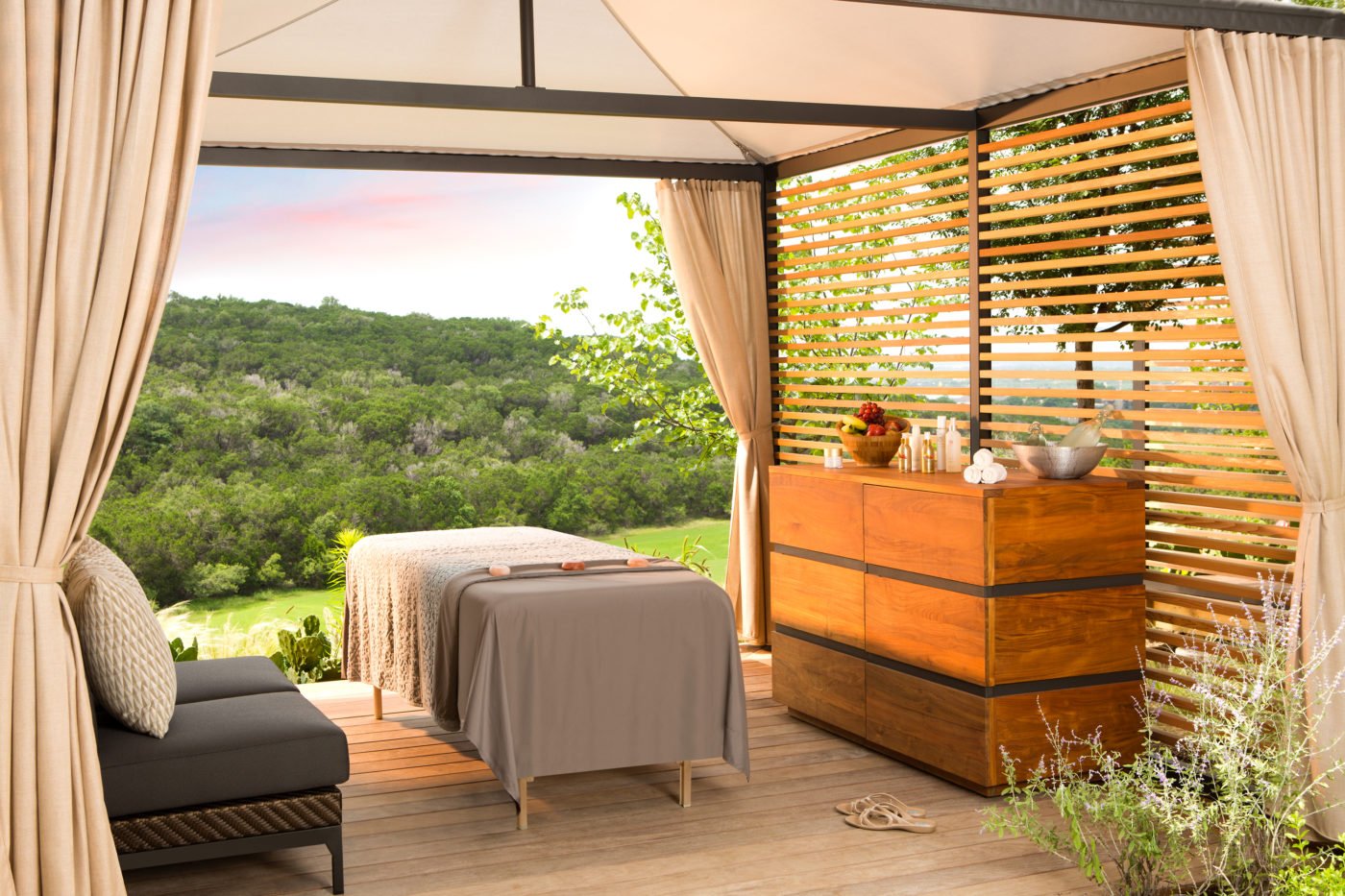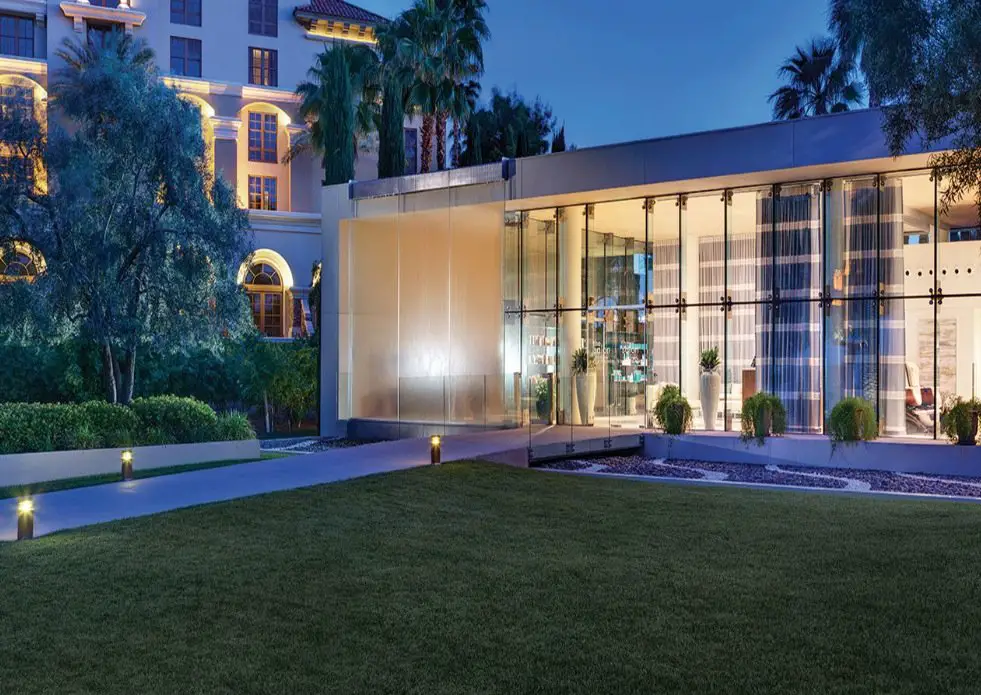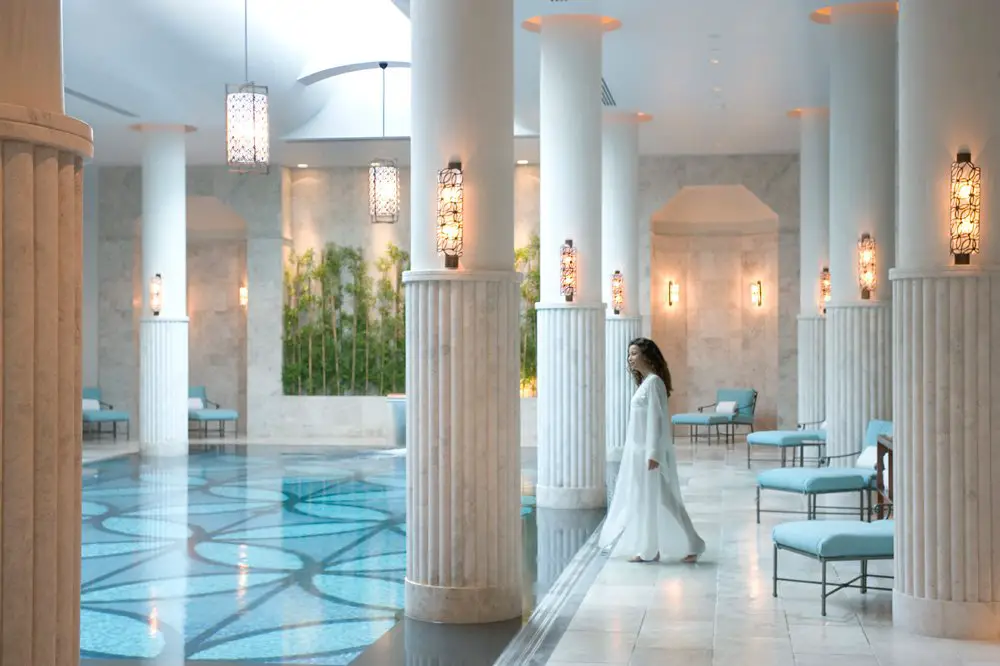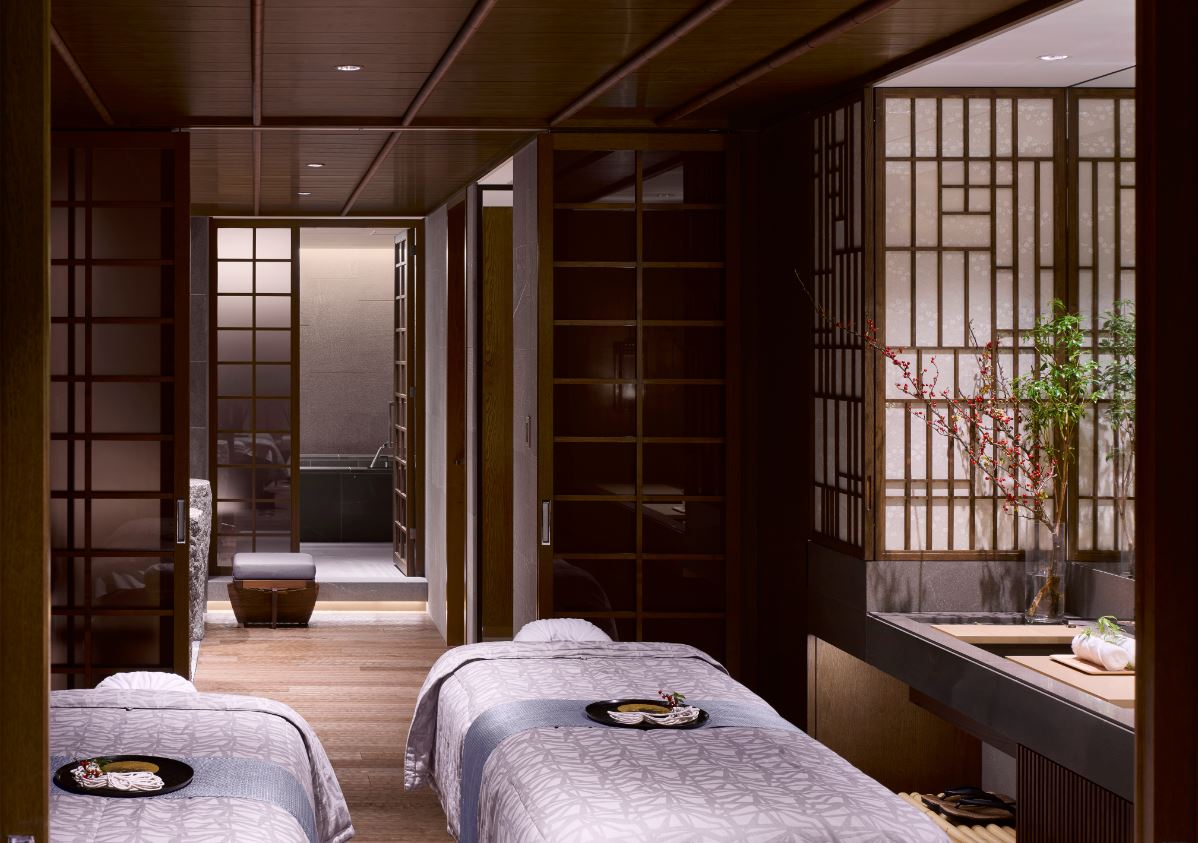Talking spa design with Cary Collier and Doug Chambers, the owners of BluSpas. Clients have included Four Seasons Resorts, Nobu Hotels, Waldorf-Astoria, Fairmont Hotels & Resorts, and many more luxury destinations.
Out of all the buzzy trends that go in and out of popularity every year, here’s one that we’re thrilled to see sticking—wellness. Sticking doesn’t even quite do it justice, though, as reports from the Global Wellness Institute estimate that the wellness economy is worth an estimated $3.7 trillion. So, how does this sector continue to not only bask but also boom?
Well, for one, it addresses the basic human desire to improve upon one’s circumstances—to be happier, healthier, more well rested, more energetic, the list goes on. But perhaps even more importantly—and like most other success stories—this industry simply has the right people at its helm.
Exhibit A: Cary Collier and Doug Chambers. This unlikely pair—a Texan cowboy and a lawyer from the OC—joined forces in 2001 to create Blu Spas Inc., a design, consulting and management company for international spa, salon, fitness and wellness. They may have started from scratch, but their rise has been one to watch; Blu Spas now boasts more than 400 spas in over 35 countries. And this duo not only preaches about enriching quality of life, they’re also practicing parishioners.
Need your daily dose of positives vibes? Below we chat with Collier and Chambers about their passion for the industry, what makes the Blu Spa experience unique, and their most helpful tips for would-be wellness seekers.

What is it about the wellness (and specifically spa) industry that initially drew you in? Have you always been passionate about health and wellness?
CARY: My life is and always will be active. I owned an aerobic studio and gym in the early 80s and that is when I first heard of “spa”. This led me to Dallas, where I was on the opening team as a fitness trainer and instructor for one of the first hotel spas in the country, The Spa at The Crescent, Hotel Crescent Court – Rosewood.
The immersion into spa and wellness was a life game-changer. Because of the visionary leadership of Robert Zimmer and Toni Beck and the superb facilities and services, The Spa at The Crescent would be on trend today, but this was 1986. It became apparent that this was a life direction I could not ignore. It is also where I met my wife, Kim. In 1990, we lived, worked and were married in Hong Kong and then moved to Bali, Indonesia, where we lived a dream life and were able to work around Asia, India and Dubai, and be introduced to many wonderful cultures. We were pioneers in a new industry that was raging to flourish. Health and wellness awakened and filled my karmic punch bowl—and still does.
DOUG: I was drawn to the industry, in part, because it seemed such a stark contrast to the law industry, the industry in which I’d spent the first portion of my adulthood. I was drawn to the opportunity to be involved in projects demanding both creativity and business skills. The chance to participate in projects that promised positive experiences for people, that introduced wellness in a variety of easily-embraced ways, appealed to me.

Four Seasons Kyoto Pool
Locality plays a big part in your designs. What is your process for getting a true feel for a project’s city?
CARY: We learned many great lessons living in Bali and traveling and working around Asia about how important it is to respect culture, heritage and traditions. Our preference is to have the time to immerse into a location, as there are a wondrous variety of questions, concepts and crafting to be sorted out. However, we do not always have this opportunity or time. So, then design is refined by research and talking with locals, marketers and operators in-country. The discovery process guides us to tell the story for the project and stakeholders.
You mention on your site that your team “breathes soul” into spas. What are the aspects of a space that convey that sense of depth and tangible feeling to a guest?
CARY: My mantra has always been to create a “sensory sanctuary” for our projects. Nature is the main act wherever possible. Our role is to orchestrate layers of detail so the end results are memorable guest experiences. The flow, site-lines, crafting of indoor and outdoor spaces, the lighting, the sounds, the aromas, the art. and the preponderance of texture—these are all treasured and need a happy ending. More and more. sacred architecture, biophilic design, and sustainable everything [are used as well]. All and more are becoming our north star for planning or must-haves to achieve authentic definitions for wellness developments in hospitality, residential and community projects. It takes a village of architects, designers, hoteliers, spa directors and, of course, the best of our planet Earth, to plan, and design and operate a knock-out wellness spa and fitness concept—one that is a “feel good” place.

Loma de Vida at La Cantera Resort and Spa
What specific projects/spaces that your team has created have connected the most with you?
CARY: The original design of The Spa at Nusa Dua Beach Hotel, in 1995, was the first free standing spa villa on the planet. Thereafter, everything about the original design of The Spa at Four Seasons at Jimbaran Bay, Bali, was extraordinary. [For example,] the use of local artists for all furniture, fixtures, fabrics, and products, including the “Jamu Bar”. These Bali Spas were the most feel good, happy places and spaces in my memory, even 20 years later.
Alvadora Spa at Royal Palms Resort in Phoenix, Arizona, was a similar experience as Bali; we had the right people at the right time to make magic happen. Others to come were Salishan Spa in Oregon, as well as Green Valley Ranch & Red Rock in Las Vegas. SilverLeaf in Scottsdale [and] Kakui’ula in Kauai bring back fond memories. We have been most fortunate to work on numerous Four Seasons projects: Istanbul, on the Bosphorus, Kyoto, Hong Kong, Marakkech, Bahrain, Kuwait, and—opening in 2018—Greece, Brazil and Tunisia.
Most recently is the Loma de Vida Spa at La Cantera Resort & Spa, a Destination Hotel in San Antonio, Texas. As a native Texan, this was a project that I really wanted and worked to get. And I had the pleasure to work with a respected friend, Maggy Dunphy of Two Roads Hospitality. My favorites spaces at Loma de Vida are the “Sky Lofts”. They overlook the Texas Hill Country, with interiors for treatments (and the views!) plus outdoor decks with “cowboy bath tubs,” showers, and lounging (and more views!).
We are launching a new wellness concept that is in design and believe will shine bright for lodging, residential, community, and hot springs projects. Can’t talk about it yet; we really want to, but the wait is almost over!

Green Valley Ranch Spa Entrance in Las Vegas
DOUG: I’m a firm believer that it starts with the concept and then it’s the coordination of, and attention to, all the nuances that together infuses the “soul” into spas. Our team is fortunate to have a very cohesive and complementary sense of the direction for a spa and we’ve had the good fortune of collaborating with extraordinary architects and interior designers.
A connection to nature / the outdoors, including the thoughtful use of natural elements, is strong variable in creating this sensation. Additionally, it’s the deliberate and mindful attention to all the senses and when all the elements of the spa align seamlessly that help to create a cohesive and compelling space for the guest.
Is there a certain city or area that you’d love to work in that you haven’t yet?
CARY: Would love to return to Costa Rica. We had a project there that was cancelled, but would love to go back. When we lived in Bali, we had friends who had lived in Bali for years but considered Costa Rica the place to retire. The “Pura Vida” spirit of the people and the abundant nature to live and play all make Costa Rica a rare place on the planet.
With wellness as a new “frontier,” it makes me think of places like Hawaii, parts of Central & South America, Mexico, and Greece as other dream places to work. Returning to Asia, where our lives were changed forever, will always be on our list. From the heart and soul is the hope to have more work in Montana, where we have lived for almost 20 years, raised our children and will always call home. Even the soul of the Earth needs quiet beautiful places and I believe Montana has many of them.
Having designed spas that span so many countries and cultures, what is the most unconventional treatment you have tried that proved to be effective?
CARY: 1994—Banyan Tree Spa [in] Phuket, Thailand—my first Thai massage in an outdoor garden on a “sala” platform pavilion. Everything about the setting and experience was a first for me, from the Thai PJs, Thai music, style and flow of the massage to the therapist’s grace and smile.
Other stand-outs: Russian Banya (followed by vodka shots) in New York City—at the crescendo of rustling, steamy birch branches drumming up and down my body, I was at my earthly limit of hot. I was about to scream as I thought my body was going to burst into flames, then a cold bucket of water saved me. It was perfect. On a nearby beach where we lived in Bali, an older Balinese man gave me the Bali version of an Ashiatsu massage (barefoot massage). He had stretched a rope between two coconut trees so he could balance as he walked and toe-jabbed me to submission. My memory recalls him smiling the entire time as he cracked more bones than I thought I had. It was fantastic. Having a ‘skin scrub’ in Hong Kong and something similar in a Turkish bath or hammam in Istanbul, where you are shown a ball of skin at the end. The ball of skin is your skin from being scrubbed and shined like an old shoe. It was cleansing. Temazcal in Mexico and Sioux Indian Sweat Lodge near Sedona—both left me in happy tears and were unforgettable. Soaking at a hot spring and walking in a river in Montana (or anywhere) revive my spirit. Nature is the most effective healer.

Four Seasons Istanbul Bosphorous Spa Pool
DOUG: Two drastically different experiences come to mind; the first was more unexpected than unconventional and the second was decidedly unconventional. The first experience was one of a spectacular one-hour foot treatment I had in Hong Kong on the morning of my departing flight at an easily-overlooked hole-in-the-wall spa that was recommended to me by the concierge at my nearby hotel. Everything about the experience, from the seating to the foot soaking basin, was strictly utilitarian and nothing that could even remotely be considered luxury standards … and still, the sequence, from the foot soak to the reflexology to the lower leg massage, was nearly hypnotically relaxing and was completely memorable. I walked away feeling rejuvenated with my only regret being I hadn’t indulged in this each day of my trip.
The second experience was more recent in a salt flotation pool. I’ve been researching and trying out various salt flotation experiences over the past couple of years, including those that offer sensory deprivation. This experience stood out because it was in a grotto-like setting and, after drifting off in an other-worldly state of weightlessness floating, I awoke a couple of hours later feeling spectacular.

Four Seasons Kyoto Spa Suite
What is something that is missing or lacking in the wellness industry that your team would like to embark on remedying?
CARY: Bring back FUN. Remember these words: “Go out and PLAY!” Remember this Montana saying: “There is no bad weather, just bad clothing.” Get outside and get dirty.
DOUG: One of the things that keeps me intrigued with the wellness industry is the seemingly endless opportunities to improve the offerings, the guest experience and to engage people in wellness. I believe that our notion of wellness and how to achieve wellness will continue to evolve, ideally in directions that make it more accessible. As Cary said, “Bring back FUN,” which includes social, communal experiences and those experiences in which when we get lost in the moment
The wellness industry is booming, and travelers have more options to choose from right now than ever. What tips do you have for travelers who are overwhelmed with the possibilities and unsure of how to plan a wellness experience that is best suited for their personal rejuvenation?
CARY: You have to do your homework; make an effort to find the right place. Of course the location is part of the draw and the variety of nature is critical to me. In my opinion, it’s paramount to get to know as best you can the people who will be guiding you. Reviews are great, but talk to people that have had the experience you’re seeking. To me, the thrill of a great wellness quest is the adventure of trying new things. Embrace being a beginner at something and that you might not excel at that something. It’s safe and easy to stick to things you are already good at, and also easy to get very, very bored. We become what we think about—it’s that simple.
DOUG: They should pause to reflect whether their goal is stress relief / rejuvenation, to kick start or advance a self-improvement goal, some combination of these or some new adventure. I believe that one of the driving elements to most wellness experiences is to take us out of our daily routines, to free us, even if briefly, from the patterns and thoughts that stifle us and restrict our growth. One of the exciting things happening over the last few years is that the range of options of wellness experiences has been growing year over year and becoming more accessible.
The post Designing Wellness: Interview With BluSpas, The World’s Premiere Luxury Spa Consultants appeared first on Pursuitist.
from Pursuitist https://pursuitist.com/interview-with-bluspas-the-worlds-premiere-luxury-spa-and-wellness-consultant/ via Your #1 Source to Finding Luxury & Designer Goods, Handbags & Clothes at or Below Wholesale: Click Here.
No comments:
Post a Comment